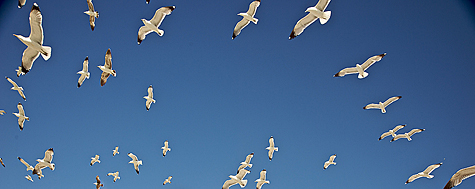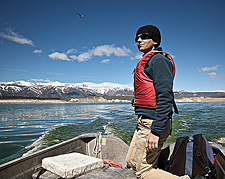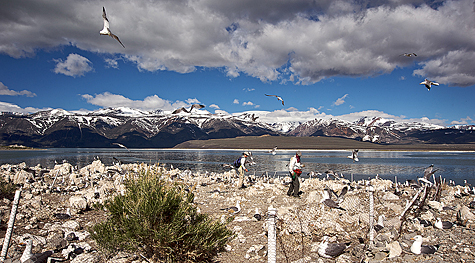
This post was written by Abby Rivin, 2011 Mono Lake Intern.
I was eight years old and it was my first visit to Sea World.

After viewing a spectacular performance by the famous whale, Shamu, I was walking down the boardwalk, munching on a delicious churro, a doughy cinnamon stick, when a seagull landed on my head. While grasping onto my hair, the gull proceeded to peck at my tasty snack. I was terrified. Ever since this horrifying experience, I duck when the shadow of a gull passes over my head. It was not until this summer when I came to work as an intern at the Mono Lake Committee that my fear began to wane and my curiosity about these birds began to grow.

A few weeks ago I attended the Mono Lake Committee’s Refreshments with Refreshing Biologists lecture series featuring biologist Kristie Nelson to learn more about these birds who have the gumption to land on the heads of pedestrians with tasty snacks. Kristie Nelson is the current lead PRBO Conservation Science biologist conducting gull research at Mono Lake. This research has been occurring since 1983 when biologists began standardized monitoring of the gull population. Kristie and a team of biologists and volunteers journey to gull colonies on the islets around Negit Island to measure the population size and reproductive success of the California Gulls as they relate to changing lake levels and other conditions. Several factors like shrimp concentrations and spring temperatures significantly influence the California Gull population at Mono Lake.
The PRBO researchers investigate if individual gulls join other colonies and where they go in the non-breeding season through color banding. Through banding recoveries, researchers have discovered that gulls winter along the Pacific coast as far south as Baja California. The long-term data PRBO biologists have gathered over the years is necessary to measure the effects of gradual change. This long-term perspective is useful to determine human-caused changes vs. natural changes in the environment.

One of the more common myths that Kristie dispelled in her discussion is that there is no such thing as a “seagull” but instead many different species of gulls throughout the world. The “seagull” that I thought landed on my head could have been a California Gull, a Western Gull, a Ring-billed Gull, or a Heermann’s Gull. By attending Kristie’s talk, my fear of the gull has been replaced with fascination and appreciation.
